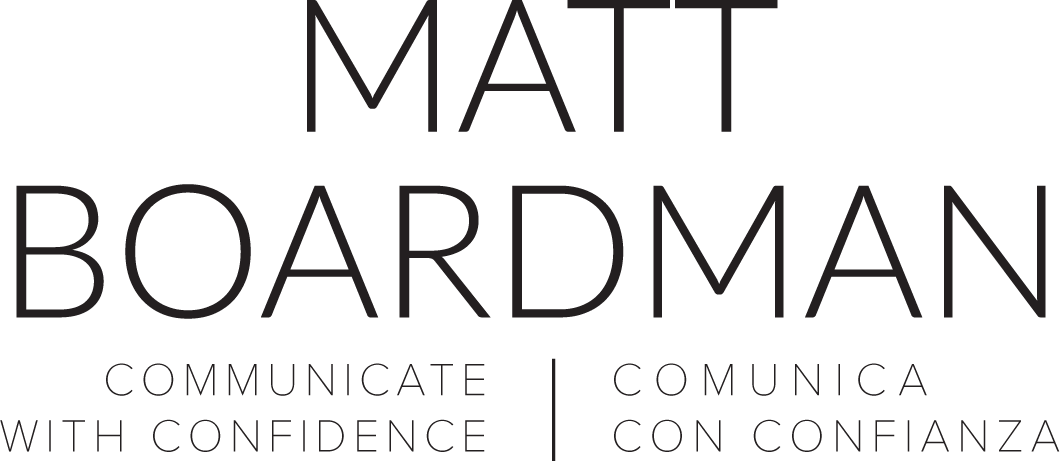How often, in a conversation of more than two people, have you felt you had to jump in as quickly as possible to make yourself heard? In this post I'm going to show you why a squeaky novelty parrot is what you need to get more out of every single group discussion from now on.
If you read last week’s post on smiling, you’ll know that after a recent move to Madrid I have found my Spanish is, while sufficient for general conversation, hindering my ability to connect with people on the same level as I can in English. This has recently proved to be particularly true in group conversations, and in a way that has made me realise how often I have unintentionally made it hard for other people to contribute.
This week I attended two workshops run by the phenomenal organisation tejeRedes, who help organisations fine-tune their awareness of what it means to interact consciously in a team (partly with the inventive use of orange thread!).
At work with tejeRedes in the mildly crypt-like but excellent venue La Tortuga in Lavapies, Madrid.
Lacking fluency in a group social situation like a workshop has made me appreciate two things:
- How much effort it takes to properly listen to the previous speaker
- The tiny amount of time we leave after one speaker before another begins drastically reduces the ability of participants who need longer to think (whether because of language difficulties or a preference for longer reflection)
Spanish friends have told me, with a vaguely mischievous sense of pride, that it can be difficult to interject here because interrupting is much more common than in Britain. But I think it’s more than that. The problem is one I have seen in London as many times as in Madrid.
The problem
During a frenetic discussion about democracy in traditional organisations, I suddenly remembered Susan Cain’s words: “Our most important institutions, our schools and our workplaces, they are designed mostly for extroverts”. I’m not suggesting that introverts are in any way akin to people struggling with a foreign language. What I am suggesting is that, because I needed longer to plan my next contribution than usual, a group conversation in Spanish threw into sharp relief why fast-paced group discussion can be a tar pit for introverts. In Honey and Mumford’s theory of learning styles, it is good practice when designing any training course to include activities which allow for a few moments of reflection. This can be as simple as giving everyone 30 seconds to write their ideas on a post-it note, but it greatly increases contributions from ‘reflectors’ (who are often also, but not always, introverts) who prefer to fully consider the issue before speaking. In any group discussion, in a workshop, at a networking event or at a dinner party, how much time do we usually allow for everyone to think before we start talking?
Extroverts are particularly guilty of making the faulty assumption that because they have their next contribution ready within 0.2 seconds of the end of the previous speaker’s sentence, so does everyone else. Based on this assumption, even a minuscule pause allows everyone a level playing field to contribute. It doesn’t.
The second consequence of our habitually tiny pauses is this: anyone who wants to compete for the 0.2 second window of opportunity must have started thinking about their contribution during the previous speaker’s. It doesn’t take a social scientist of world renown to work out that this makes us much less able to digest what the previous speaker is saying.
So what’s the solution?
During one hectic workshop debate our facilitator Cristian introduced, like a toyshop deus ex machina, a squeaky novelty parrot. The rule, as aficionados of conch-based infantile mediation will know, is that only the person holding the parrot is allowed to speak.
The parrot provided helpful visual emphasis of the importance of turn-taking in human interaction. But for me, more important than that was the functional 2-3 pause it enforced. Each time a speaker finished, it took a few seconds for them to look around the room to the next person wanting to speak and pass them (often with unwittingly dangerous velocity) the squeaky novelty parrot.
I am not suggesting that you should from now on bring to every group discussion a squeaky novelty parrot, as it could be inappropriate in certain situations such as black tie dinners (though it should perhaps be considered for some members of the Turkish parliament). My point is this: if we could remember to leave a habitual 2-3 second pause (scientifically proven as the average time taken to pass a squeaky novelty parrot from one person to another) after the end of each contribution, two things would happen:
- The previous speaker would have everyone’s undivided attention
- Everyone in the discussion would have long enough to digest the previous speaker’s contribution, think of their own, and have a fair chance at getting their own airtime
Next time you’re in a group conversation, try to notice how much silence is left at the end of each person’s speech. Notice also the people in the group who aren’t speaking much. Is it because they’ve genuinely nothing to say, or is there a faint glimmer of frustration in their eyes each time they fail to get their words ready in the split-second pause?
What do you think? Please use the comments below to tell me your experience with pauses and turn-taking in group discussions.




